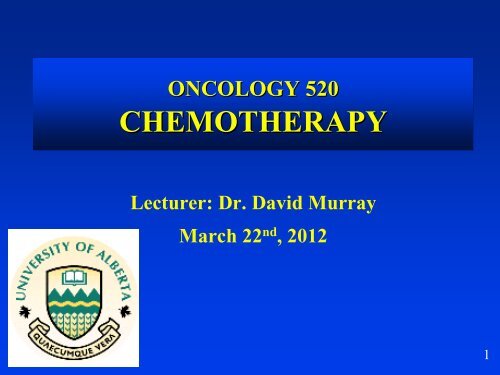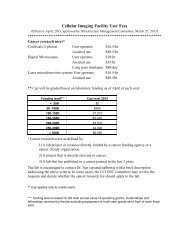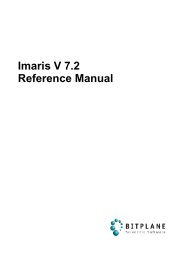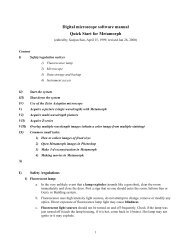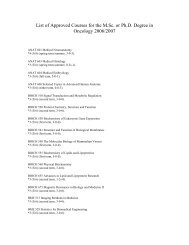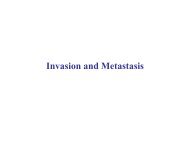Principles of Chemotherapy - Experimental Oncology Graduate Study
Principles of Chemotherapy - Experimental Oncology Graduate Study
Principles of Chemotherapy - Experimental Oncology Graduate Study
You also want an ePaper? Increase the reach of your titles
YUMPU automatically turns print PDFs into web optimized ePapers that Google loves.
ONCOLOGY 520CHEMOTHERAPYLecturer: Dr. David MurrayMarch 22 nd , 20121
<strong>Chemotherapy</strong> (CT): General points• 35 CT drugs are currently available in North America; ~15 are in common use.• Many patients receive CT at some point in their management.• Useful symptom relief and disease arrest are <strong>of</strong>ten obtained.• CT is generally used as:(a)(b)(c)(d)the major curative modality for malignancies such as Hodgkin's disease andother lymphomas, acute childhood leukemia, and testicular cancer;palliative treatment for many advanced cancers;adjuvant treatment before ("neo-adjuvant") or after ("post-adjuvant") localtreatment (surgery or XRT) for primary disease with the aim <strong>of</strong> eradicatingoccult micrometastases; orin combination with other modalities (usually XRT) to improve their therapeuticeffects.2
Combination CT• Improvements in CT have come largely from the use <strong>of</strong> drug combinations.• Some drugs were combined because <strong>of</strong> a theoretical or experimental basisfor expecting synergistic interaction based on mechanisms <strong>of</strong> action.• Synergy only leads to a therapeutic benefit if the interaction between drugsis preferential/specific for the tumor.• Important factors underlying the success <strong>of</strong> combination CT include:(a) ability to combine drugs at close to full tolerated doses with additiveeffects against tumors and less than additive toxicities to normal tissues; and(b) potential avoidance <strong>of</strong> the development <strong>of</strong> drug resistance (e.g., in thecombined use <strong>of</strong> doxorubicin and cyclophosphamide).• Most drugs exert dose-limiting toxicity for the bone marrow, but this is notthe case for vincristine (neurotoxic), cisplatin (nephrotoxic), or bleomycin(mucositis and lung toxicity). 3
Therapeutic Index• All anticancer drugs have normal tissue toxicity that limits the dose that canbe given.• If a drug is to be useful, its antitumor effects must occur at lower doses thanthose that cause dose-limiting normal-tissue toxicity.• Therapeutic index may bedefined as the ratio <strong>of</strong> the dosesrequired to produce a givenprobability <strong>of</strong> toxicity andantitumor effect.• E.g., the ratio <strong>of</strong> doses thatproduce a 5% probability <strong>of</strong>severe toxicity and 50%probability <strong>of</strong> antitumor effect.Source: IF Tannock and RP Hill, Basic Science <strong>of</strong><strong>Oncology</strong>. 3 rd Ed., McGraw-Hill, 1998.4
Therapeutic Index, contd.• Such dose-response curves have been defined only rarely forhumans.• Improving the therapeutic index is the goal <strong>of</strong> experimental CT.• Any modification in treatment that leads to increased antitumoreffect must be assessed for its effects on critical normal tissuesprior to therapeutic trials.5
Relationship between tumor remission and cure• For most solid tumors, the limit <strong>of</strong> clinical/radiologicaldetection is ~1 g <strong>of</strong> tissue (∼10 9 cells).• If CT can reduce the number <strong>of</strong> malignant cells below thislimit <strong>of</strong> detection, the patient is described as being incomplete clinical remission.• Even in a "surgically confirmedcomplete remission" there maybe many tumor cells. Tumorcure requires eradication <strong>of</strong> allclonogenic tumor cells.• Attaining complete remission isonly a small step toward tumorcure.Adapted from Tannock and RP Hill, Basic Science <strong>of</strong> <strong>Oncology</strong>. 3 rd Ed., McGraw-Hill, 1998.6
Relationship between remission and cure, contd.• As with XRT, repopulation may occur between courses, so the number <strong>of</strong>tumor cells may change with time. If each CT course kills 90% <strong>of</strong> thetumor cells and starting from a large (100 g) tumor, complete clinicalremission is achieved after 3 courses. However, a further 6 to 10 courseswould be required to achieve cure.• Important to continue aggressivetreatment during completeremission.• Unfortunately, for most solidtumors, a drug-resistantresistant subpopulationemerges and leads torelapse.• This is the major barrier tosuccessful CT.Source: IF Tannock and RP Hill, Basic Science <strong>of</strong><strong>Oncology</strong>. 3 rd Ed., McGraw-Hill, 1998.7
Clinical resistance to CT agents• Clinically, 2 classes <strong>of</strong> drug resistance are apparent: intrinsic and acquired. E.g.,in breast cancer or small-cell cancer <strong>of</strong> the lung some patients do not respond totheir initial CT (intrinsic resistance); others respond to the initial treatment,but acquired resistance to further therapy usually prevents drug treatment frombeing curative.• Even if drug-resistant cells are present initially only at low frequency (e.g., 1per 10 5 cells), their selective advantage during treatment will lead to their rapidemergence as the dominant cell population and to relapse.• Clinically important drug resistance is probably due to both genetic (e.g., pointmutation and gene amplification) and epigenetic (e.g., changes in patterns <strong>of</strong>DNA methylation that influence gene expression) mechanisms.8
Classes <strong>of</strong> anticancer drugs• “Classical” anticancer drugs are grouped into several families based ontheir biochemical activities/origins:ALKYLATING AGENTSNitrogen MustardChlorambucilMelphalanCyclophosphamideBusulfanChloroethyl nitrosoureas:BCNUCCNUMethyl-CCNUANTIMETABOLITESMethotrexate5-FluorouracilCytosine arabinoside6-Thioguanine6-MercaptopurineGemcitabineNATURAL PRODUCTSDoxorubicin (Adriamycin)DaunorubicinActinomycin CBleomycinMitomycin CVinblastineVincristineVP-16 (Etoposide)MISCELLANEOUS AGENTSCisplatinCarboplatinDTIC (Dacarbazine)9
1. Alkylating agents• Highly reactive electrophilic drugs that form covalent bonds with anumber <strong>of</strong> electron-rich groups <strong>of</strong> biological molecules (such as amino,phosphate, sulfhydryl, and hydroxyl groups).• Have either 1 (mon<strong>of</strong>unctional) or 2 (bifunctional) electrophilic sidechains.• Major mechanism <strong>of</strong> cytotoxicity involves interaction with DNA bases.• Bifunctional drugs can form DNA interstrand cross-links (ISCs).• Major classes <strong>of</strong> alkylating agents include:(a) nitrogen mustards (e.g., melphalan, cyclophosphamide);(b) chloroethyl nitrosoureas (e.g., BCNU, CCNU, methyl-CCNU); and(c) methane sulfonic acid esters (e.g., busulfan).10
a. Nitrogen mustards• Bifunctional drugs with 2 electrophilic chloroethyl (-CH 2 CH 2 Cl)groups that alkylate DNA predominantly at the electron-rich N-7position <strong>of</strong> guanine.R11
Mechlorethamine (nitrogen mustard)Louis Goodman and AlfredGilman in San Francisco, 1955.• The first drug used for modern cancer CT, it is now used mainly to treatHodgkin's lymphoma as part <strong>of</strong> the MOPP regimen (combinedMechlorethamine-vincristine (Oncovin)-Procarbazine-Prednisone).• Problems with clinical use because <strong>of</strong> its high reactivity.• Because <strong>of</strong> its rapid reaction rate, mechlorethamine must be given i.v.• As with all alkylating agents, bone marrow function is depressed.12
Melphalan (LMelphalan(L-phenylalanine mustard)• One <strong>of</strong> several modified mustards thatwere synthesized in an attempt toproduce a drug that would preferentiallylocalize in a particular tumor.• Phenylalanine is a precursor <strong>of</strong> melanin; a phenylalanine mustard derivativemight accumulate in melanomas and produce a selective toxicity.• Although this effect was not achieved, melphalan is a very useful drug.• The presence <strong>of</strong> the electron-withdrawing aromatic ring next to the nitrogenslows the rate <strong>of</strong> cyclization (immonium ion formation) and thus <strong>of</strong> alkylation,making melphalan much less reactive than mechlorethamine.• This allows time for absorption and wide distribution before extensivealkylation occurs.• It also means that the drug can be given orally.• Melphalan crosslinks DNA in a manner similar to mechlorethamine.• Principally used to treat multiple myeloma; also ovarian/breast tumors.• Major toxicity is bone marrow suppression.13
Cyclophosphamide (Cytoxan; Ctx)• Another "modified" mustard developed inthe hope that might be preferentiallyactivated in tumor cells. High phosphataseand phosphoramidase activity had beenobserved in some tumors; cleavage <strong>of</strong> thephosphamide ring might produce an activecompound within the tumor cells.• Although such selectivity was not achieved, the drug has a wide application in CT.• Ctx is a nontoxic pro-drug that is metabolically activated to 4-hydroxyCtx bymicrosomal cytochrome P-450 in the liver.• Used to treat CLL, multiple myeloma, Hodgkin's disease, non-Hodgkin's lymphomas,ALL, Burkitt's lymphoma, and a variety <strong>of</strong> solid tumors, including Ewing's sarcoma,rhabdomyosarcoma, neuroblastoma, and carcinomas <strong>of</strong> the breast, lung, and ovary.• Given either orally or i.v.14
. Chloroethyl nitrosoureas• The 2-chloroethyl carbonium ion( + CH 2 CH 2 Cl) is the alkylatingmoiety <strong>of</strong> these drugs.• BCNU has 2 chloroethyl groups,whereas CCNU and methyl-CCNU are mon<strong>of</strong>unctionalagents. BCNU induces ISCs.• Nitrosoureas are highly lipophilic and readily pass into thecerebrospinal fluid. For this reason they are used to treat tumors inthe CNS <strong>of</strong> both primary and metastatic origin.• Significant activity in Hodgkin's disease and melanoma and usefulin 2ndry therapy <strong>of</strong> non-Hodgkin's lymphomas and lung/colorectalcancers.• BCNU is given i.v. CCNU and methyl-CCNU are usually givenorally.• Largely replaced by Temozolomide (Temodar®) for brain tumors.Temodar15
Effects <strong>of</strong> alkylating agents on mammalian cellsAlkylating agents have a number <strong>of</strong> important biological effects,including:• Cell killing and apoptosis: since the aim <strong>of</strong> CT is cure or long-termremission, the critical factor for drug efficacy is the killing <strong>of</strong> tumor stemcells.• Cell-cycle arrest: cells treated with alkylating agents display a markedarrest in G 2 phase.• Mutation and transformation: alkylating agents <strong>of</strong>ten cause secondarymalignancies; there is increased risk if patients also receive XRT.16
2. AntimetabolitesDrugs that resemble normal metabolites and that compete as substrates forenzyme activity.5-fluorouracil (5FU)• An inhibitor <strong>of</strong> thymidylate synthase (TS).• Widely used for breast and gastrointestinal (GI) cancers.• Major toxicity is to bone marrow and mucous membranes.17
Antimetabolites, contd.Methotrexate• Competitively inhibits dihydr<strong>of</strong>olate reductase (DHFR), theenzyme that converts folic acid to reduced folate c<strong>of</strong>actors (i.e.,tetrahydr<strong>of</strong>olate).• Use includes osteosarcoma, non-Hodgkin's lymphoma,Hodgkin's disease, cutaneous T cell lymphoma, head and neckcancer, lung and breast cancers.• Given orally or intrathecally.• Toxicity: immunosuppressive.18
Antimetabolites, contd.Cytosine arabinoside (Ara-C)• Ara-C differs from deoxycytidine in having a β-OH group on the 2-position <strong>of</strong>the sugar, so its sugar moiety is arabinose rather than deoxyribose.• A competitive inhibitor <strong>of</strong> DNA polymerase; it also incorporates into DNA.• Used primarily to treat acute leukemia.• Bone marrow toxicity is major side effect.• Others: gemcitabine, fludarabine, cladribine.19
3. Natural productsDoxorubicin and related drugs• Doxorubicin (Adriamycin) is a planar 4-ring anthracycline molecule linked to thesugar daunosamine. It has a wide range<strong>of</strong> clinical activity for many solid tumorsand leukemia.• Cytotoxicity is mediated by intercalationand by the induction <strong>of</strong> topoisomerase IImediatedDNA strand breaks.• Epirubicin and daunorubicin areanalogues <strong>of</strong> doxorubicin.Amsacrine (AMSA)• A synthetic acridine derivativethat causes topoisomerase IImediatedDNA strand breaks.• Used mainly in the treatment <strong>of</strong>acute leukemia.20
Natural products, contd.Actinomycin D• Used mainly in the treatment <strong>of</strong>childhood tumors.Bleomycin• Causes DNA strand breaks through acomplex sequence <strong>of</strong> reactions thatinvolves the binding <strong>of</strong> a bleomycin-Fe(II) complex to DNA.• Used in combination CT for testicularcancer and lymphomas.21
Natural products, contd.Vinca Alkaloids• Vinblastine and Vincristine are multi-ring compounds derived from theperiwinkle plant.• They bind to tubulin, thus inhibiting its polymerization to form microtubules anddisrupting the mitotic spindle.Vinblastine is an important drug in combination CT <strong>of</strong> testicular cancer.• Vincristine is a mainstay <strong>of</strong> treatment for childhood leukemia.Vincristine22
Natural products, contd.VP-16 and VM-26• VP-16 (etoposide) and VM-26(teniposide) are semisyntheticglycoside derivatives <strong>of</strong>podophyllotoxin that targettopoisomerase II. Etoposide• VP-16 is used to treat small-celllung cancer, testicular cancer,and lymphomas.Mitomycin C• Acts similarly to alkylatingagents.• More active against hypoxicthan against aerobic cells intissue culture. 23Mitomycin C
Natural products: Taxanes• Taxanes (taxol, taxotere) stabilize microtubules.• Widely used in the treatment <strong>of</strong> breast cancer.24
4. “Platinating” agents: Cisplatin and Carboplatin• Act by a mechanism similar to thealkylating agents.• Cisplatin is used in drug combinationsthat can cure testicular cancer and palliatea variety <strong>of</strong> solid tumors.• Carboplatin is an analogue <strong>of</strong> cisplatinthat has come into clinical use.• Newer compounds include tri-nuclearplatinating agents.25
Mechanism <strong>of</strong> resistance to anticancer drugsTumor cells may develop resistance to CT drugs througha number <strong>of</strong> mechanisms, including:1. Transport.2. Glutathione and associated enzymes.3. DNA repair.4. Tolerance to DNA damage.5. Drug-specific mechanisms.26
1. Transport• Mutation/altered expression <strong>of</strong> a drug transportprotein leading to decreased drug uptake (foragents such as melphalan and mechlorethaminethat are actively transported).27
Nucleoside analogs: Membrane transportproteins and drug resistance• Drug-specific transporters such as hENT1 (human equilibrative nucleosidetransporter 1) are responsible for the uptake <strong>of</strong> important anticancer nucleosideanalogs, such as gemcitabine.• Down-regulation <strong>of</strong> hENT1 might thus represent a mechanism <strong>of</strong> resistance tosuch drugs.G hENT1 G dCK GP GPPPCN-II1Courtesy <strong>of</strong> Dr. J. Mackey.28
Nucleoside analog responsiveness and hENT1• hENT1 immunohistochemistryon 21 consecutive patientstreated with gemcitabine forpalliation <strong>of</strong>advanced/recurrent pancreaticadenocarcinoma.1009080PERCENT SURVIVING70605040Kaplan-Meier Survival by hENT1 Intensityfrom Gemcitabine Initiation (n=21)p = 0.014negpos30201000 6 12 18 24 30MONTHSJ. Spratlin, R. Sangha, D. Glubrecht, L. Dabbagh, J.Young, C. Dumontet, C. Cass, R. Lai, J. Mackey.Clin Cancer Res. 2004;10:6956-61.Overall patient survival from initiation<strong>of</strong> gemcitabine therapy in pancreaticcancer29
Drugs associated with MDR and increasedexpression <strong>of</strong> p-glycoproteinp•The "multi-drug resistance" or MDR-associated drugs: amplification <strong>of</strong> the mdrgenes that encode the ~170 kDa membrane P-glycoprotein (MDR1) that effectsthe efflux <strong>of</strong> drug from resistant cells.•Also “multidrug resistance protein (MRP) and others.Actinomycin DColchicineDaunorubicinDoxorubicinEpirubicinEtoposide (VP-16)MitoxantronePuromycinVinblastineVincristineVindesineCourtesy <strong>of</strong> M. O’Leary website.30
2. Glutathione and associated enzymes• Cells can synthesize high concentrations <strong>of</strong> nucleophilic sulfhydryl compoundssuch as glutathione (GSH), which can react with electrophilic drugs and renderthem less toxic and more easily excreted.• GSH is a tripeptide <strong>of</strong> γ-glutamic acid/cysteine/glycine.• GSH synthesis can be inhibited by buthionine sulfoximine (BSO). BSO hasundergone extensive clinical trials for reversing clinical drug resistance.• Conjugation with GSH is catalyzed by glutathione S-transferases S(GST),which have several isozyme forms that are encoded by multiple genes.• Some drug-resistant cell lines have increased activity <strong>of</strong> one or more GSTs.• Increased levels <strong>of</strong> metallothioneins, proteins rich in sulfhydryl-containingcysteine residues, are associated with resistance to alkylating agents andcisplatin.31
3. DNA repair• DNA ISCs are the major cause <strong>of</strong> cytotoxicity for the bifunctional alkylatingagents and cisplatin.• Increased ability to repair ISCs is <strong>of</strong>ten a factor in the development <strong>of</strong>resistance to these drugs.• E.g., drug-resistant human tumor cells have been found to over-express aspecific DNA-repair gene such as ERCC1 that mediates the repair <strong>of</strong> ISCs.32
4. Tolerance to DNA damage• In many studies, an increased ability <strong>of</strong> drug-resistant cells to"tolerate" DNA damage has been described which is not directlyassociated with increased DNA repair.• Mechanisms <strong>of</strong> tolerance include the loss <strong>of</strong> proteins thatrecognize DNA damage, such as the mismatch repair (MMR)proteins and the high-mobility group (HMG)-domain family <strong>of</strong>proteins.• Well established for cisplatin, the extension <strong>of</strong> this mechanism toother drugs is uncertain.33
Tolerance by blockage <strong>of</strong> apoptosis• Some CT agents kill tumor cellsby collaborating with the cellsapoptotic (suicide) program,which must be functional for thecell to be sensitive to treatment.FasLFasFADDPro-caspase-8Bid<strong>Chemotherapy</strong>, XRTBaxBH3-proteinsMCBcl-2/Bcl-X• Alterations in pathways thatdetect damage and transmitsignals to the apoptoticmachinery may contribute totolerance.Caspase 8Caspase 3Cyto-CApaf-1Caspase 9• Mutations that result in the loss<strong>of</strong> factors responsible fortriggering apoptosis cancontribute to resistance to CTagents.Caspase 6Caspase 7Caspase XDEATH SUBSTRATESAPOPTOSISIAP34
5. Drug-specific mechanisms• Ctx: aldehyde dehydrogenase (ALDH) is an enzyme thatinactivates the active metabolite <strong>of</strong> Ctx before it can damageDNA.• BCNU, Temozolomide: O 6 -alkylguanine DNAalkyltransferase is a “suicide” enzyme that removes adductsfrom the O 6 position <strong>of</strong> guanine.• Methotrexate: amplification <strong>of</strong> the gene encoding the drug'starget enzyme, dihydr<strong>of</strong>olate reductase (DHFR).• 5FU: amplification or over-expression <strong>of</strong> the gene encoding thedrug's target enzyme, thymidylate synthase (TS).• AMSA, doxorubicin, VP-16 and VM-26: decreased activityand/or presence <strong>of</strong> variant forms <strong>of</strong> topoisomerase II.35
Proliferation dependency <strong>of</strong> cell killing• Most CT agents are more cytotoxic toward rapidly proliferating thannon-proliferating cells, i.e., they are "proliferation-dependent" agents.• These include the nitrogen mustards, doxorubicin and 5FU.• Exceptions include BCNU, CCNU and cisplatin.• This factor is generally 1-2-fold,but Ctx has a greater (2-5-fold)specificity for cycling cells.• Proliferative rate is therefore amajor determinant <strong>of</strong> drugactivity.• For example, doxorubicin.36
Cell-cycle phase specificity <strong>of</strong> CT agents• Most drugs show a marked variation in cytotoxicity around the cell cycle.• Alkylating agents are cell cycle phase non-specific (i.e., they kill cells in allphases <strong>of</strong> the cell cycle). However, they do kill differentially in the variousphases, being more cytotoxic in G 2 /M and at the G 1 /S boundary.• Antimetabolites are generally toxic onlyto cells that are synthesizing DNA;methotrexate and doxorubicin havemaximum toxicity for S-phase cells buthave some activity during the otherphases.• Surprisingly, Vincristine andVinblastine are toxic to cells in S phase,which is presumably when formation <strong>of</strong>the mitotic spindle is initiated.37
Novel approaches to CT[1] Directed drug deliveryImproved CT responses might beobtained by:• Linking drugs to antibodies or growthfactors that recognize antigens orreceptors on tumor cells (cf. RIT).• Entrapment <strong>of</strong> drugs such asDoxorubicin in lipid vesicles known asliposomes.• The site <strong>of</strong> localization depends on thesize <strong>of</strong> the liposomes and theirmembrane composition.• Liposomes might overcome drugresistance that is due to decreasedmembrane transport.• Ditto nanoparticles.38
[2] Use <strong>of</strong> high-dose CT through overcomingbone marrow toxicity• CT dosage is usually limited bytoxicity to bone marrow.• Reduction <strong>of</strong> these toxic effects maybe achieved by co-administration <strong>of</strong>growth factors such as G-CSF andGM-CSF.• Bone-marrow transplantation(BMT) allows high-dose CT.• Marrow may be derived from otherhistocompatible individuals(allogeneic BMT) or from thepatient prior to CT (autologousBMT).Source: Dr. L Ruth website.39
Bone marrow transplantation• Allogeneic BMT has been used successfully in the treatment <strong>of</strong>acute leukemia.• Autologous BMT is being used in clinical trials for lymphomapatients.• Developments in autologous BMT include novel methods for exvivo chemopurging (e.g., 4-hydroperoxy-Ctx) or immunopurging(e.g., Shigella like toxin).40
Bone marrow transplantation and gene therapy?• Strategies aim tomanipulate bone marrowstem cells ex vivo.• Examples are themultidrug resistance(MDR) gene and theDNA repair gene O6-alkylguanine DNA alkyltransferase (AGT).CD34 + -PurifiedBone Marrow CellsA gene therapy protocol in which the MDR gene is transferred invitro into cytokine-treated CD34+ bone marrow precursors. Cellsfrom this patient were infected with a recombinant RV carrying theMDR gene and reinfused into the patient before high-dose CT wasadministered41
[3] The next generation: Rational CT?Designer drugs for the treatment <strong>of</strong> cancers with consistent molecular alterations• Can we target molecular changes, such as the bcr-ablfusion protein tyrosine kinase (PTK) that is characteristic<strong>of</strong> CML cells?The Philadelphia chromosome42
Gleevec (imatinib mesylate), formerly known as STI5743
[4] Approaches to eradicating hypoxic tumor cells• Hypoxic cell cytotoxins (bioreductive drugs) target a different population <strong>of</strong> tumor (i.e.,hypoxic) cells than XRT, resulting in a complementary pattern <strong>of</strong> cytotoxicity.Gradient <strong>of</strong> reduced cell killing as a function <strong>of</strong> distance from the vasculature as seem inexperimental tumors and spheroids.From R Urtasun and JM Brown, Chemical Modifiers <strong>of</strong> Radiation, in “Textbook <strong>of</strong> Radiation <strong>Oncology</strong>”. Eds. SA Leibel and TL Phillips, Saunders, 2004.44
Hypoxic-cell cell cytotoxins: Tirapazamine• The drug Tirapazamine (TPZ)) is metabolized by cellular reductases. When oxygenis present the drug is rapidly oxidized back to the parent drug and the relatively non-toxic molecule superoxide.• In hypoxic cells, the •TPZ radical causes DNA double-strand breaks and single-strand breaks.Metabolism <strong>of</strong> TPZ to its active free-radical moiety causing preferential toxicity to hypoxic cells bydamaging DNA.JM Brown. Mol Med Today 6:157-162;200045
TirapazamineKilling <strong>of</strong> mouse SCCVII cells exposed for 1 h to different concentrations ntrations <strong>of</strong> TPZ under eitheraerated ()() or hypoxic (•)() conditions. HCR = hypoxic cytotoxicity ratio.JM Brown. Mol Med Today 6:157-162;200046


